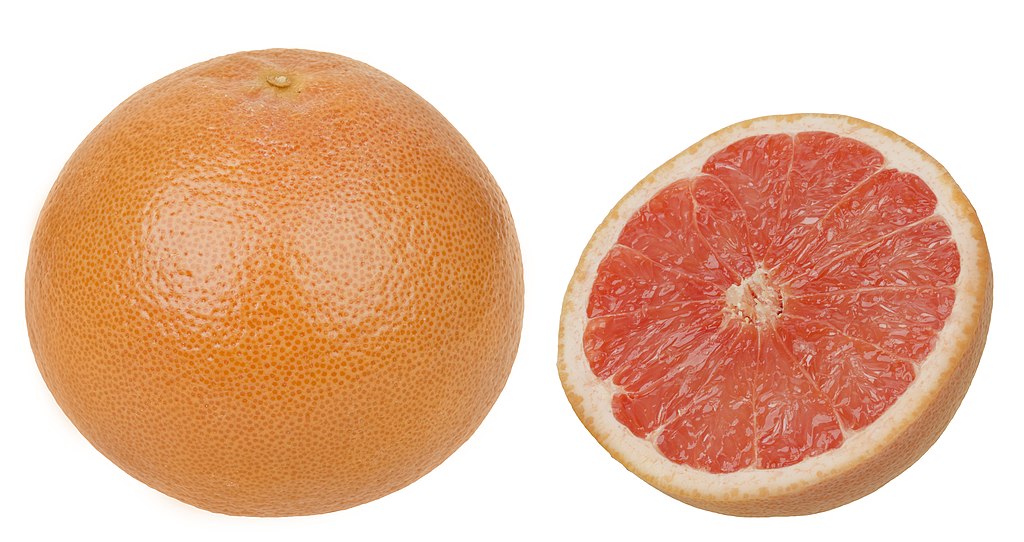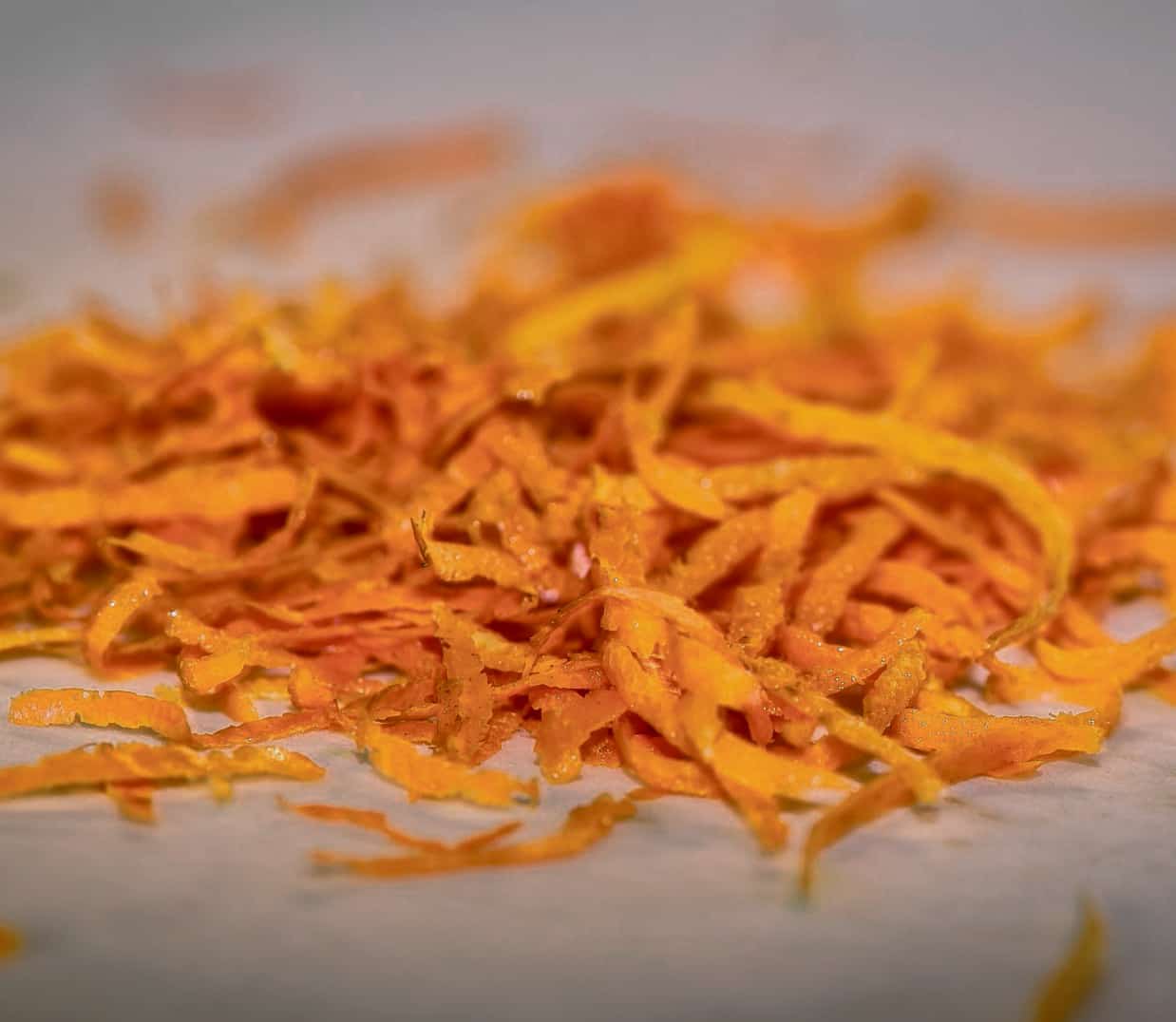Grapefruit vs. Orange Zest
Nutrition comparison of Grapefruit and Orange Zest
Ever wonder how your favorite foods stack up against each other in terms of nutrition?
We compared the nutritional contents of
grapefruit
versus
orange zest
(100g each)
below using 2020 USDA and NIH data[1].
For a quick recap of significant nutrients and differences in grapefruit and orange zest:
- Both orange zest and grapefruit are high in Vitamin C.
- Grapefruit has 57% less calories than orange zest.
- Grapefruit has 57% less carbohydrates than orange zest.
- Orange zest has more thiamin, riboflavin, niacin, Vitamin B6 and folate.
- Orange zest is a great source of potassium.
- Orange zest is an excellent source of calcium and dietary fiber.
USDA sources for nutritional information: Grapefruit (Grapefruit, raw, pink and red, all areas) and Orange Zest (Orange peel, raw) . Have a correction or suggestions? Shoot us an email.
Calories and Carbs
calories
Grapefruit has 57% less calories than orange zest - orange zest has 97 calories per 100 grams and grapefruit has 42 calories.
For macronutrient ratios, grapefruit is similar to orange zest for protein, carbs and fat. Grapefruit has a macronutrient ratio of 7:91:3 and for orange zest, 6:94:0 for protein, carbohydrates and fat from calories.
Macro Ratios from Calories:
| Grapefruit | Orange Zest | |
|---|---|---|
| Protein | 7% | 6% |
| Carbohydrates | 91% | 94% |
| Fat | 3% | ~ |
| Alcohol | ~ | ~ |
carbohydrates
Grapefruit has 57% less carbohydrates than orange zest - orange zest has 25g of total carbs per 100 grams and grapefruit has 10.7g of carbohydrates.
dietary fiber
Orange zest is an excellent source of dietary fiber and it has 563% more dietary fiber than grapefruit - orange zest has 10.6g of dietary fiber per 100 grams and grapefruit has 1.6g of dietary fiber.
sugar
Orange zest has less sugar than grapefruit - grapefruit has 6.9g of sugar per 100 grams and orange zest does not contain significant amounts.
Protein
protein
Orange zest and grapefruit contain similar amounts of protein - orange zest has 1.5g of protein per 100 grams and grapefruit has 0.77g of protein.
Fat
saturated fat
Both orange zest and grapefruit are low in saturated fat - orange zest has 0.02g of saturated fat per 100 grams and grapefruit has 0.02g of saturated fat.
Vitamins
Vitamin C
Both orange zest and grapefruit are high in Vitamin C. Orange zest has 336% more Vitamin C than grapefruit - orange zest has 136mg of Vitamin C per 100 grams and grapefruit has 31.2mg of Vitamin C.
Vitamin A
Grapefruit has 176% more Vitamin A than orange zest - orange zest has 21ug of Vitamin A per 100 grams and grapefruit has 58ug of Vitamin A.
Vitamin E
Orange zest and grapefruit contain similar amounts of Vitamin E - orange zest has 0.25mg of Vitamin E per 100 grams and grapefruit has 0.13mg of Vitamin E.
The B Vitamins
Orange zest has more thiamin, riboflavin, niacin, Vitamin B6 and folate. Both grapefruit and orange zest contain significant amounts of pantothenic acid.
| Grapefruit | Orange Zest | |
|---|---|---|
| Thiamin | 0.043 MG | 0.12 MG |
| Riboflavin | 0.031 MG | 0.09 MG |
| Niacin | 0.204 MG | 0.9 MG |
| Pantothenic acid | 0.262 MG | 0.49 MG |
| Vitamin B6 | 0.053 MG | 0.176 MG |
| Folate | 13 UG | 30 UG |
Minerals
calcium
Orange zest is an excellent source of calcium and it has 632% more calcium than grapefruit - orange zest has 161mg of calcium per 100 grams and grapefruit has 22mg of calcium.
iron
Orange zest has 900% more iron than grapefruit - orange zest has 0.8mg of iron per 100 grams and grapefruit has 0.08mg of iron.
potassium
Orange zest is a great source of potassium and it has 57% more potassium than grapefruit - orange zest has 212mg of potassium per 100 grams and grapefruit has 135mg of potassium.
Omega-3 and Omega-6
omega 3s
For omega-3 fatty acids, both grapefruit and orange zest contain significant amounts of alpha linoleic acid (ALA).
| Grapefruit | Orange Zest | |
|---|---|---|
| alpha linoleic acid | 0.008 G | 0.011 G |
| Total | 0.008 G | 0.011 G |
omega 6s
Comparing omega-6 fatty acids, both grapefruit and orange zest contain small amounts of linoleic acid.
| Grapefruit | Orange Zest | |
|---|---|---|
| linoleic acid | 0.029 G | 0.029 G |
| Total | 0.029 G | 0.029 G |
Customize your serving size
The comparison below is by common portions, e.g. cups, packages. You can also see a more concrete comparison by weight at equal weight (by grams) comparison.
Note: The specific food items compared are: Grapefruit (Grapefruit, raw, pink and red, all areas) and Orange Zest (Orange peel, raw) .
Grapefruit g
()
|
Daily Values (%) |
Orange Zest g
()
|
|||||
|---|---|---|---|---|---|---|---|
| KCAL % |
|
5% | calories | 5% |
|
KCAL % | |
| G % |
|
5% | carbohydrates | 5% |
|
G % | |
| G % |
|
5% | dietary fiber | 5% |
|
G % | |
| G | 5% | sugar | 5% | G | |||
| G % |
|
5% | total fat | 5% |
|
G % | |
| G % |
|
5% | saturated fat | 5% |
|
G % | |
| G | 5% | monounsaturated fat | 5% | G | |||
| G | 5% | polyunsaturated fat | 5% | G | |||
| G | 5% | trans fat | 5% | G | |||
| MG | 5% | cholesterol | 5% | MG | |||
| MG % |
|
5% | sodium | 5% |
|
MG % | |
| 5% | Vitamins and Minerals | 5% | |||||
| UG % |
|
5% | Vitamin A | 5% |
|
UG % | |
| MG % |
|
5% | Vitamin C | 5% |
|
MG % | |
| IU % |
|
5% | Vitamin D | 5% |
|
IU % | |
| MG % |
|
5% | calcium | 5% |
|
MG % | |
| MG % |
|
5% | iron | 5% |
|
MG % | |
| MG % |
|
5% | magnesium | 5% |
|
MG % | |
| MG % |
|
5% | potassium | 5% |
|
MG % | |
| MG % |
|
5% | thiamin (Vit B1) | 5% |
|
MG % | |
| MG % |
|
5% | riboflavin (Vit B2) | 5% |
|
MG % | |
| MG % |
|
5% | niacin (Vit B3) | 5% |
|
MG % | |
| MG % |
|
5% | Vitamin B6 | 5% |
|
MG % | |
| MG % |
|
5% | pantothenic acid (Vit B5) | 5% |
|
MG % | |
| UG % |
|
5% | folate (Vit B9) | 5% |
|
UG % | |
| UG % |
|
5% | Vitamin B12 | 5% |
|
UG % | |
| MG % |
|
5% | Vitamin E | 5% |
|
MG % | |
| UG % |
|
5% | Vitamin K | 5% |
|
UG % | |
| G % |
|
5% | protein | 5% |
|
G % | |
| UG % |
|
5% | biotin (Vit B7) | 5% |
|
UG % | |
| MG % |
|
5% | choline | 5% |
|
MG % | |
| MG % |
|
5% | chlorine | 5% |
|
MG % | |
| UG % |
|
5% | chromium | 5% |
|
UG % | |
| MG % |
|
5% | copper | 5% |
|
MG % | |
| UG % |
|
5% | fluoride | 5% |
|
UG % | |
| UG % |
|
5% | iodine | 5% |
|
UG % | |
| MG % |
|
5% | manganese | 5% |
|
MG % | |
| UG % |
|
5% | molybdenum | 5% |
|
UG % | |
| MG % |
|
5% | phosphorus | 5% |
|
MG % | |
| UG % |
|
5% | selenium | 5% |
|
UG % | |
| MG % |
|
5% | zinc | 5% |
|
MG % | |
| G | 5% | Water | 5% | G | |||
| G | 5% | Starch | 5% | G | |||
| G | 5% | Alcohol | 5% | G | |||
FAQ
Does orange zest or grapefruit contain more calories in 100 grams?Grapefruit has 60% less calories than orange zest - orange zest has 97 calories in 100g and grapefruit has 42 calories.
Does orange zest or grapefruit have more carbohydrates?
By weight, grapefruit has 60% fewer carbohydrates than orange zest - orange zest has 25g of carbs for 100g and grapefruit has 10.7g of carbohydrates.
Does orange zest or grapefruit contain more calcium?
Orange zest is a rich source of calcium and it has 630% more calcium than grapefruit - orange zest has 161mg of calcium in 100 grams and grapefruit has 22mg of calcium.

